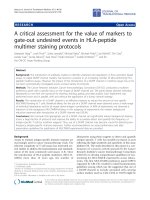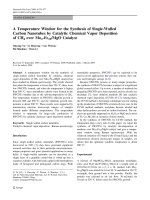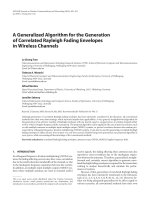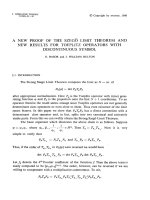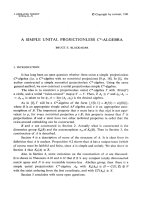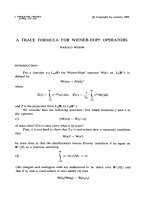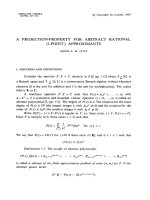Báo cáo toán học: "A simple proof for the existence of exponentially balanced Gray codes" ppsx
Bạn đang xem bản rút gọn của tài liệu. Xem và tải ngay bản đầy đủ của tài liệu tại đây (76.5 KB, 5 trang )
A simple proof for the existence of
exponentially balanced Gray codes
I Nengah Suparta
∗
Department of Applied Mathematics
Faculty of Electrical Engineering, Mathematics and Computer Science
Delft University of Technology
P.O. BOX 5031, 2600 GA Delft, The Netherlands
Submitted: Apr 21, 2005; Accepted: Sep 9, 2005; Published: Oct 13, 2005
Mathematics Subject Classifications: 94A05, 94A12, 94A15, 94C30
Abstract
AGraycodeoflengthn is a circular list of all 2
n
bitstrings or binary codewords
of length n such that successive codewords differ in only one bit position. The fre-
quencies of the positions where these differences occur are called transition counts.
An exponentially balanced Gray code is a Gray code the transition counts of which
are all the same power of two, or are two successive powers of two. A proof for the
existence of exponentially balanced Gray codes is derived. The proof is much sim-
pler than an earlier proof presented by van Zanten and Suparta (Discrete Analysis
and Operation Research, 11 (2004) 81-98 (Russian Journal)).
Keywords: Gray codes, exponentially balanced Gray codes, transition count spec-
trum.
1 Introduction
A Gray code G(n)oflengthn is a circular list of all 2
n
bitstrings or binary codewords of
length n such that successive codewords differ in one bit position. The frequencies of the
positions where these differences occur are called transition counts in [2, 4, 11]. If a Gray
code is such that any two transition counts differ at most two, one says that this Gray
code is balanced, and it is called totally balanced or uniform if all its transition counts are
equal (cf. [2, 11]). The transition counts can be called exponentially close if they are all
the same power of two, or are all two consecutive powers of two. We call a Gray code
∗
On leave from Dept. of Mathematics, IKIP Negeri Singaraja, Bali - Indonesia
the electronic journal of combinatorics 12 (2005), #N19 1
with this property an exponentially balanced Gray code (cf. [10]), as a generalization of
(totally) balanced Gray codes. Thus, for an exponentially balanced Gray code G(n)one
has that the transition count of every bit position i,1≤ i ≤ n, is equal to 2
e(i)
for some
positive integer e(i), and |e(i) − e(j)|≤1, 1 ≤ i, j ≤ n. It was proved in [10, Theorem 4]
that a Gray code G(n) is totally balanced if and only if e(i)=e(j) for all i, j.
In [11], Wagner and West conjectured that exponentially balanced Gray codes exist
for all length n. By extending the method of Robinson and Cohn for the construction of
Gray codes in [5], van Zanten and Suparta in [10] proved the conjecture of Wagner and
West in positive sense. In this note we present a proof based on Bakos’s construction of
Gray codes in [1] which was reformulated in a simple way by Knuth in [4, Theorem D].
This proof is much simpler than the one given in [10].
In the sequel, codewords in a Gray code G(n) will be indexed from 0 to 2
n
− 1. The
codeword with index i,0≤ i ≤ 2
n
− 1, is denoted by x
i
,whereasx
0
is identified with x
2
n
.
Let s
i
,1≤ i ≤ 2
n
, be the bit position where codewords x
i−1
and x
i
differ in the list of
G(n). We call the integers s
i
, transition numbers or shortly transitions. The sequence
of transitions s
i
,1≤ i ≤ 2
n
, denoted by
¯
S(n):=s
1
,s
2
, , s
2
n
, is called the transition
sequence of G(n). The last transition s
2
n
is occasionally called the closing transition of
¯
S(n). Moreover, we write
¯
S(n)
j
,0≤ j ≤ 2
n
− 1, for the cyclic shift of
¯
S(n)overj po-
sitions to the left. For instance, the 3-bit Gray code 000, 001, 011, 010, 110, 111, 101, 100,
has transition sequence
¯
S(3) = 3, 2, 3, 1, 3, 2, 3, 1, while
¯
S(3)
3
=1, 3, 2, 3, 1, 3, 2, 3. With
respect to the transition sequence of G(n), the transition count of the integer i, denoted
by TC
n
(i), is equal to the number of times the integer i occurs in
¯
S(n). The distribu-
tion TC
n
:=(TC
n
(1),TC
n
(2), , T C
n
(n)) of the transition counts of G(n) is called the
transition count spectrum of G(n). The above 3-bit Gray code has the transition count
spectrum (2
1
, 2
1
, 2
2
).
Sometimes authors prefer to consider the distribution (
TC
n
(1)
2
n
,
TC
n
(2)
2
n
, ,
TC
n
(n)
2
n
) instead of
TC
n
, which is referred to as the bit error probabilities of G(n) (see e.g. [3, 6]).
It should be mentioned here that the Gray code constructions in [4, Theorem D], [9],
and in [8, 10], which are an extended version of the construction in [5], are all modified
versions of a method of Bakos in [1], who proved his results in quite a different context,
and who’s work was unnoticed for long by authors of articles in the field of ordered codes.
Furthermore, we remark that an extension of [4, Theorem D] which holds for the opposite
parity of l, was introduced in [4, Exercise 50 ] and was also proved in [7, Construction 1].
2 A construction of Gray codes
In this note the word subsequence (of some sequence S) stands for what sometimes is
called a contiguous or consecutive subsequence, i.e. all elements of this subsequence are
consecutive in S.Letu be a subsequence of
¯
S(n) which may be empty. We denote by
u
R
the sequence obtained from u by reversing its order. The following theorem is due to
Knuth [4, Theorem D]. The differences in notation and the opposite parity of l compared
the electronic journal of combinatorics 12 (2005), #N19 2
with the formulation in [4] are due to our convention with respect to the labelling of bit
positions and the indexing of codewords as introduced in Section 1.
Theorem 2.1 Let
¯
S(n):=u
0
,j
0
,u
1
,j
1
, , u
l−1
,j
l−1
,u
l
,j
l
be the transition sequence of an
n-bit Gray code, where each j
k
is a single transition, each u
k
is a possibly empty sequence
of transitions, and l is even. Then the sequence
u
0
,j
0
,u
1
, , j
l−1
,u
l
,n+1,u
R
l
,n+2,u
l
,n+1,u
R
l
,j
l−1
u
R
l−1
,n+1,u
l−1
,n+2,u
R
l−1
,j
l−2
, u
R
1
,n+1,u
1
,n+2,u
R
1
,j
0
,
u
R
0
,n+2,u
0
,n+1,u
R
0
,n+2,
is the transition sequence of an (n +2)-bit Gray code.
In the proof of Theorem 3.1 below, the sequence j
0
,j
1
, , j
l−1
, will be denoted by T .
Thus, the length of the sequence T is equal to l. We emphasize that the sequence T does
not include the closing transition s
2
n
:= j
l
of
¯
S(n), as is evident from the notation in
Theorem 2.1.
It is easy to observe that the Gray code of length n + 2 constructed by applying
Theorem 2.1, has transition count spectrum (TC
n+2
(1),TC
n+2
(2), , T C
n+2
(n +2)), with
TC
n+2
(i):=
l +2, if i = n +1,n+2,
4TC
n
(i) − 2b(i), if i ∈{1, , n}\{s
2
n
},
4(TC
n
(i) − 1) − 2b(i), if i = s
2
n
.
(1)
where b(i) is the number of times the integer i occurs in the sequence T . Note that the
sum of all b(i), 1 ≤ i ≤ n,isequaltol, the length of T .
3 A simple proof for the existence of exponentially
balanced Gray codes
As mentioned in Section 1, the existence of exponentially balanced Gray codes was a
longstanding conjecture of Wagner and West in [11]. In [10] we introduced a technique
how to construct exponentially balanced Gray codes by applying the Robinson-Cohn Gray
code construction [5], thus proving the conjecture of Wagner and West,
Theorem 3.1 For every n ≥ 1, there exists an n-bit exponentially balanced Gray code,
and if n is a power of two, there exists an n-bit totally balanced Gray code.
Here, we shall present a proof using Theorem 2.1. The proof is constructive like the
proof in [10], but much simpler.
the electronic journal of combinatorics 12 (2005), #N19 3
Proof: We accomplish the proof using the principle of mathematical induction. It is
obvious that Gray codes of length 1, 2, and 3 are exponentially balanced. Assume that
an exponentially balanced Gray code G(n)oflengthn ≥ 3 exists with transition count
spectrum
(TC
n
(1),TC
n
(2), , T C
n
(n)) := (2
v
, , 2
v
k
, 2
v+1
, , 2
v+1
n−k
), (2)
for some k with 0 ≤ k<n. We distinguish two cases: n − k>1andn − k =1.
Case I. n − k>1. This case implies that TC
n
(n − 1) = TC
n
(n)=2
v+1
. Let
¯
S(n)bethe
transition sequence of G(n), and let i be some integer in {0, 1, , 2
n
− 1} such that the
closing transition of
¯
S(n)
i
is the integer n. Take a sequence T from the cyclically shifted
transition sequence
¯
S(n):=
¯
S(n)
i
with length l := 2
v+2
− 2, consisting of 2
v+1
− 2 occur-
rences of integer n and all 2
v+1
occurrences of integer n−1. Here, b(1) = ···= b(n− 2) = 0,
b(n − 1) = 2
v+1
,andb(n)=2
v+1
− 2. Apply Theorem 2.1 with this sequence T .Thenwe
obtain a Gray code of length n + 2 with transition counts satisfying the following (cf. eq.
(1))
TC
n+2
(i):=
2
v+2
, for all i ∈{1, , n +2}\{k +1, , n − 2},
2
v+3
, for all i ∈{k +1, , n − 2}.
Thus, the resulting Gray code of length n + 2 is exponentially balanced with transition
count spectrum (2
v+2
, ,2
v+2
k+4
, 2
v+3
, ···, 2
v+3
n−k−2
).
Notice that if n−k = 2 or equivalently n+2 = 2
n−v
(a power of two), the resulting (n+
2)-bit Gray code is totally balanced with transition count spectrum (2
v+2
, 2
v+2
, , 2
v+2
).
Case II. n − k = 1. The transition count spectrum (2) now becomes
(TC
n
(1),TC
n
(2), , T C
n
(n)) := (2
v
, ,2
v
n−1
, 2
v+1
). (3)
Here, the transition count of integer n is equal to 2
v+1
. Again we assume that n is the
closing transition of
¯
S(n)
i
, for some integer i,0≤ i ≤ 2
n
− 1. Take a sequence T from
¯
S(n):=
¯
S(n)
i
consisting of only 2
v+1
−2 occurrences of integer n, and then apply Theorem
2.1. The resulting Gray code of length n + 2 will have transition counts
TC
n+2
(i):=
2
v+1
, if i = n +1,n+2,
2
v+2
, if i ∈{1, , n}.
the electronic journal of combinatorics 12 (2005), #N19 4
Again the resulting Gray code of length n + 2 is exponentially balanced with transition
count spectrum (2
v+1
, 2
v+1
, 2
v+2
, ,2
v+2
n
).
We see that in each case the produced Gray code is exponentially balanced. Since
exponentially balanced Gray codes of length 1, 2, and 3 exist, the Theorem is proved now
by the principle of mathematical induction.
Acknowledgements The author is indebted to Prof. Dr. A.A. Evdokimov (Novosi-
birsk State University) and Prof. Dr. A.J. van Zanten (Delf University of Technology) for
drawing his attention to reference [1]. The author also would like to thank an anonymous
referee for suggestions which lead to the final presentation of this article.
References
[1] A.
´
Ad´am, Truth Functions and the Problem of their Realization by Two-Terminal
Graphs, Akad´emiai Kiad´o, Budapest 1968.
[2] G.S. Bhat, and C. D. Savage, “Balanced Gray codes”, The Electronic Journal of
Combinatorics, vol. 3 (1996), paper 25.
[3] J.E. Ludman,“Gray code generation for MPSK signal”, IEEE Trans. Comm., vol.
COM-29, No. 10 (1981), pp. 1519-1522.
[4] Donald E. Knuth, The Art of Computer Programming, Volume 4, Addison-Wesley
as part of “fascicle” 2, USA, 2005.
[5] J.P. Robinson and M. Cohn,“Counting sequence”, IEEE Trans. Computers, vol. C-
30, No. 1 (1981), pp. 17-23.
[6] Carl-Erik Sundberg, “Bit error probability properties of Gray-coded M.P.S.K. Sig-
nals”, Electronics Letters, vol. 11 (1975), pp. 542-544.
[7] I N. Suparta and A.J. van Zanten, “A construction of Gray codes inducing complete
graphs”, submitted for publication.
[8] I N. Suparta and A.J. van Zanten, “Balanced Gray codes”, rept. CS 03-03, Insti-
tute for Knowledge and Agent Technology, Universiteit Maastricht, Maastricht, The
Netherlands 2003.
[9] Suparta, I N. and A.J. van Zanten, “A note on balanced Gray codes”, submitted for
publication.
[10] A.J. van Zanten and I N. Suparta, “Totally balanced and exponentially balanced
Gray codes”, Discrete Analysis and Operation Research, vol. 11, No. 4 (2004), pp.
81-98. (Russian Journal)
[11] D.G. Wagner and J. West, “Construction of uniform Gray codes”, Congressus Nu-
merantium, vol. 80 (1991), pp. 217-223.
the electronic journal of combinatorics 12 (2005), #N19 5

